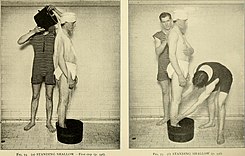Природолечение
Облик

Природолечението, наричано също натуропатия, е форма на алтернативна медицина.[1]
То включва широк кръг псевдонаучни практики, обявени за „природни“, „неинвазивни“ или насърчаващи „самолечението на организма“. Те варират от открито шарлатанство, като хомеопатията, до широко въприети практики, като някои форми на психотерапия.[2][3][4][5] Идеологията и методите на природолечението се основават на витализма и народната медицина, а не на доказателствената медицина, макар че природолечителите могат да използват и научно доказани техники.[6][7][8]
Бележки
[редактиране | редактиране на кода]- ↑ Naturopathic Medicine // Gale Encyclopedia of Alternative Medicine. 2nd. Gale, 2005. Архивиран от [ оригинала] на June 24, 2013. Посетен на March 21, 2015.
- ↑ Science, Pseudoscience, and Not Science: How do They Differ? // Healthcare and Biomedical Technology in the 21st Century. 2014. ISBN 978-1-4614-8540-7. DOI:10.1007/978-1-4614-8541-4_2. с. 19 – 57. within the traditional medical community it is considered to be quackery
- ↑ Paul S. Boyer. The Oxford companion to United States history. 2001. ISBN 9780195082098. с. 630. Посетен на January 15, 2013. After 1847, when regular doctors organized the American Medical Association (AMA), that body led the war on „quackery“, especially targeting dissenting medical groups such as homeopaths, who prescribed infinitesimally small doses of medicine. Ironically, even as the AMA attacked all homeopathy as quackery, educated homeopathic physicians were expelling untrained quacks from their ranks.
- ↑ Lilienfeld, Scott O. Introduction to special section on pseudoscience in psychiatry // The Canadian Journal of Psychiatry 60 (12). December 2015. DOI:10.1177/070674371506001202. с. 531 – 533. Although the boundaries separating pseudoscience from science are fuzzy, pseudosciences are characterized by several warning signsШаблон:Sndfallible but useful indicators that distinguish them from most scientific disciplines. ... In contrast to most accepted medical interventions, which are prescribed for a circumscribed number of conditions, many pseudoscientific techniques lack boundary conditions of application. For example, some proponents of Thought Field Therapy, an intervention that purports to correct imbalances in unobservable energy fields, using specified bodily tapping algorithms, maintain that it can be used to treat virtually any psychological condition, and that it is helpful not only for adults but also for children, dogs, and horses.
- ↑ Lee, Catherine M. и др. Evidence-based practice: separating science from pseudoscience // The Canadian Journal of Psychiatry 60 (12). December 2015. DOI:10.1177/070674371506001203. с. 534 – 540. TFT, a treatment applied to mood, anxiety, and trauma-related disorders, is a prime example of practice founded on pseudoscience. TFT is based on the premise that bodily energy imbalances cause negative emotions. Treatment is purported to rectify imbalances by tapping on acupuncture meridians. Virtually no peer-reviewed research supports this treatment rationale. With only methodologically weak reports available in the literature, the so-called science cited to support TFT is primarily anecdotal and does not rule out placebo effects. Despite these criticisms, the TFT website continues to advance unsupported claims about TFT's ability to cure almost any emotional problem.
- ↑ Evidence-based medicine and naturopathy // Journal of Alternative and Complementary Medicine 12 (3). April 2006. DOI:10.1089/acm.2006.12.323. с. 323 – 328.
- ↑ Tabish, Syed Amin. Complementary and Alternative Healthcare: Is it Evidence-based? // International Journal of Health Sciences 2 (1). 2008. с. v–ix.
- ↑ Goldenberg, Joshua Z. и др. Shifting attitudes towards research and evidence-based medicine within the naturopathic medical community // Advances in Integrative Medicine 4 (2). August 2017. DOI:10.1016/j.aimed.2017.08.003. с. 49 – 55.
|

